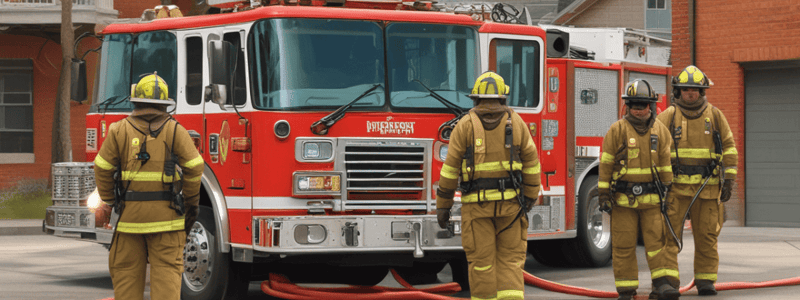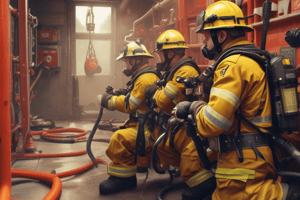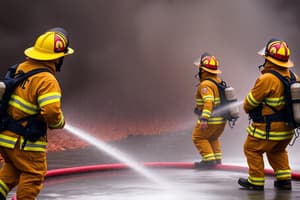Podcast
Questions and Answers
What is the most common method used by TFS crews for laying hose?
What is the most common method used by TFS crews for laying hose?
What is the primary purpose of flushing the hydrant?
What is the primary purpose of flushing the hydrant?
What is the role of the gate valve in flushing the hydrant?
What is the role of the gate valve in flushing the hydrant?
What is the disadvantage of the static hose lay method?
What is the disadvantage of the static hose lay method?
Signup and view all the answers
What is the first step in the static hose lay method?
What is the first step in the static hose lay method?
Signup and view all the answers
What is the purpose of the hydrant kit bag?
What is the purpose of the hydrant kit bag?
Signup and view all the answers
What is the first step in connecting to a hydrant?
What is the first step in connecting to a hydrant?
Signup and view all the answers
What is the purpose of the colour coded rings on 65mm hydrant ports?
What is the purpose of the colour coded rings on 65mm hydrant ports?
Signup and view all the answers
Why should pump operators consider friction loss in the 100mm supply line?
Why should pump operators consider friction loss in the 100mm supply line?
Signup and view all the answers
What is the recommended practice when water demands are high?
What is the recommended practice when water demands are high?
Signup and view all the answers
What is the first step in shutting down the hydrant?
What is the first step in shutting down the hydrant?
Signup and view all the answers
Why should apparatus attempt to use separate water mains when possible?
Why should apparatus attempt to use separate water mains when possible?
Signup and view all the answers
What is the purpose of releasing residual pressure in the hydrant?
What is the purpose of releasing residual pressure in the hydrant?
Signup and view all the answers
What should be done if a hydrant cannot be shut down?
What should be done if a hydrant cannot be shut down?
Signup and view all the answers
Why should a minimum of two 100mm supply lines be attached to the pumper at some incidents?
Why should a minimum of two 100mm supply lines be attached to the pumper at some incidents?
Signup and view all the answers
What is the purpose of draining the hydrant after use?
What is the purpose of draining the hydrant after use?
Signup and view all the answers
Study Notes
Static Lay
- In a static hose lay, the apparatus arrives at the fire scene and supply hose is dragged by a firefighter from the apparatus towards the hydrant.
- This method is commonly used by TFS crews due to the hydrant spacing in Toronto.
- The method has its disadvantages, such as distances from the hydrant, especially when flow rates increase.
Flushing the Hydrant
- Flushing the hydrant confirms the hydrant is operational before committing equipment to it.
- Flushing removes sediment and debris prior to connecting hose lines and prevents them from entering the pump and attack hose lines.
- Flushing is done in a controlled method using a gate valve, in case of a hydrant failure.
Steps to Flush the Hydrant
- Remove the 65mm hydrant cap furthest from the fire scene and attach an open 65mm gate valve with 100mm Storz adapter.
- Fully open the hydrant, with your body positioned away from hydrant outlets, and observe the water stream until it becomes clean and clear.
- Shut down the hydrant until water stops flowing and close the gate valve.
Connecting to the Hydrant
- TFS uses color-coded rings on 65mm hydrant ports to identify hydrant flow capabilities.
- Remove remaining hydrant caps and connect a second 65mm gate valve with 100mm Storz adapter to the 65mm hydrant port and ensure it is closed.
- Connect the 100mm hose to the hydrant Storz connection, and signal or radio the pump operator to confirm the hydrant has been secured.
Maximizing the Hydrant
- Use all available ports on the hydrant to maximize its water supply potential.
- At incidents with more than two hose lines, use a minimum of two 100mm supply lines attached to the pumper from the hydrant.
- When residual intake pressures approach 140 kPa, attach another 100mm supply line to the pumper from the hydrant.
- Note: At no time should two apparatus be connected to the same hydrant. Apparatus shall secure their own water supply, independent from others. Apparatus should attempt to use separate water mains when possible.
Shutting Down the Hydrant
- Ensure the pump operator no longer needs the hydrant and has closed the intake valve.
- Close the hydrant operating stem (clockwise) and release residual pressure.
- Remove all hose lines and appliances, and ensure the hydrant has no more water coming from it.
- Report the location of the hydrant to TFS Communications for hydrant servicing.
Studying That Suits You
Use AI to generate personalized quizzes and flashcards to suit your learning preferences.




